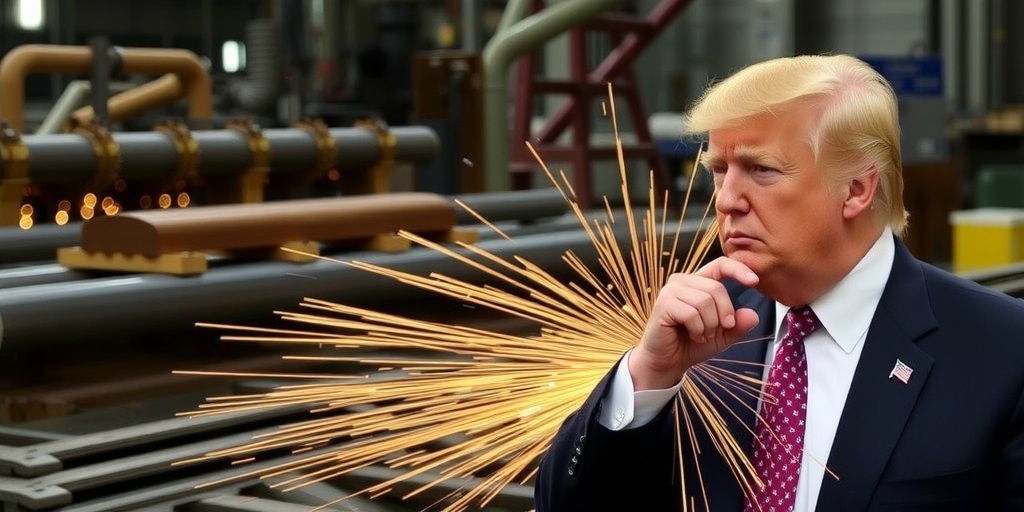Now Reading: Trump’s Steel and Aluminum Tariffs Now in Effect
-
01
Trump’s Steel and Aluminum Tariffs Now in Effect
Trump’s Steel and Aluminum Tariffs Now in Effect

Trump Reinstates Tariffs on Steel and Aluminum, Prompting Trade Tensions
In a significant move, President Donald Trump has reinstated sweeping tariffs on foreign steel and aluminum, a decision that took effect on Wednesday. This escalation highlights ongoing trade tensions between the United States and various global competitors, notably including key allies who are already contending with the ramifications of fluctuating trade penalties imposed by the Trump administration.
The newly imposed tariffs include a substantial 25 percent duty on steel and aluminum imports from all countries. This bold step has garnered support from domestic steel and aluminum manufacturers who believe it will stabilize their industries. However, the tariffs are projected to elevate production costs for American manufacturers across several sectors, including automobile production, food packaging, and renewable energy products like solar panels. Experts warn that these rising costs could potentially lead to a deceleration in overall economic growth within the United States.
Trump’s decision to impose these tariffs is part of a broader strategy to wield the power of U.S. tariffs as leverage against foreign governments, aiming to reshape trade agreements to benefit American industries. Just last week, the president had announced significant tariffs on imports from Canada, Mexico, and China, attributing the burdens of drug trafficking and immigration to the influx of goods from these nations. Following immediate pushback, Trump quickly reversed course on some of these tariffs, showcasing the fluid nature of his trade policy.
The ramifications of these tariffs have induced a market downturn as U.S. allies try to decipher the president’s true objectives. In a pointed response to the newly enacted tariffs, the European Union declared its intent to impose tariffs on approximately $28 billion worth of American goods, directly targeting the industries most affected by the tariff policies.
These tariffs are not entirely new, as they mirror the measures introduced by Trump back in 2018, which ignited a series of prolonged trade conflicts. Trump has continuously defended his approach, claiming that the tariffs are essential for national security and for ensuring a steady supply of metals for military needs during times of conflict.
Despite some praise from the steel industry itself, there is a growing concern among manufacturers who rely heavily on steel and aluminum inputs. Kevin Dempsey, president of the American Iron and Steel Institute, commented on the effectiveness of previous tariffs compared to more isolated trade actions. However, he admitted that increasing the cost of raw materials would inevitably create ripple effects throughout the economy, particularly harming the manufacturers who employ more workers than the metals industries themselves.
The recent tariffs are likely to exacerbate existing trade tensions, prompting retaliatory actions from foreign governments. Canada, for instance, has vowed to respond with levies targeted at American exporters, and it is anticipated that other countries will follow suit. Officials in Canada have already indicated plans to impose additional tariffs on up to $30 billion worth of American goods, exacerbating an already strained trade relationship.
Experts have predicted that while the tariffs may bolster the domestic steel industry marginally, they would also result in higher production costs and retail prices for consumers. At this time, the average cost of a new vehicle in the United States stands at over $48,000, with rising tariffs potentially leading to even steeper prices for automobile buyers, who are already grappling with high prices and interest rates.
The broader economic implications of these tariffs are concerning. An analysis by the U.S. International Trade Commission revealed that the previous tariffs enacted under Trump yielded a net cost to the economy, with the negative impact on downstream industries—such as automotive and machinery manufacturing—outweighing any gains experienced by the steel and aluminum sectors.
In an attempt to alleviate the backlash from these tariffs, the Trump administration has now extended their scope to include downstream goods manufactured with steel and aluminum, leading to price increases for various household items, including furniture and appliance parts. This indicates a recognition of the unintended consequences stemming from the administration’s prior tariff policies.
The ongoing cycle of protectionism is concerning to industry experts, who fear that it may invoke further pleas from different sectors for government safeguards, thereby deepening trade disputes and potentially leading to a continuous cycle of retaliatory tariffs. Chad Bown of the Peterson Institute for International Economics voiced concerns about this growing protectionist trend.
As the U.S. steps into an era marked by escalating tariffs, the potential for retaliatory measures from foreign governments looms large. With Canada and the European Union already signaling their readiness to respond, Trump’s strategy to reshape trade policies could lead to increased tensions on the global stage, impacting American exports and consumers alike.
Stay Informed With the Latest & Most Important News
Previous Post
Next Post
Previous Post
Next Post
-
 01New technology breakthrough has everyone talking right now
01New technology breakthrough has everyone talking right now -
 02Unbelievable life hack everyone needs to try today
02Unbelievable life hack everyone needs to try today -
 03Fascinating discovery found buried deep beneath the ocean
03Fascinating discovery found buried deep beneath the ocean -
 04Man invents genius device that solves everyday problems
04Man invents genius device that solves everyday problems -
 05Shocking discovery that changes what we know forever
05Shocking discovery that changes what we know forever -
 06Internet goes wild over celebrity’s unexpected fashion choice
06Internet goes wild over celebrity’s unexpected fashion choice -
 07Rare animal sighting stuns scientists and wildlife lovers
07Rare animal sighting stuns scientists and wildlife lovers





















